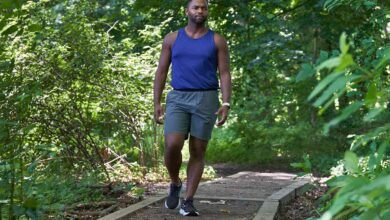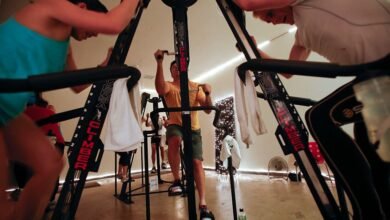Prepare for the Hills and Prevent Injuries With These Stretches for Skiers

Stretching and mobility work are crucial parts of any well-rounded fitness routine and healthy lifestyle, but when your sport of choice uses practically every muscle group and challenges your cardiovascular system, muscular endurance, power, stability, and focus, a proper stretching practice is a necessity.
“Stretching is an essential part of skiing for both novice and advanced skiers,” says Levi Frasier, PT, DPT, a physical therapist and clinic director of Peak Physical Therapy. “Stretching routines can help prevent injury, improve your performance on the hill, and help reduce soreness after skiing,”
Different stretching methods are better suited for before or after your skiing session, he adds. “Movement-based stretching would be important before skiing, and static hold stretching may be beneficial after skiing.”
Movement-based stretching includes dynamic stretches or mobility work that is more active. It is ideal for pre-skiing warm-ups, increasing blood flow, and preparing your nervous system for work. Static stretching (holding the stretch) involves more restorative stretching techniques and are best saved for apres-ski (which is a French term meaning “after skiing”). These stretches can boost recovery as well as help relax your mind, regulate your breathing, and encourage your nervous system to return to a calm.
Below, you will find some of the best stretches for skiers to do before and after skiing. These stretches will not only help you prepare for the slopes but also reduce the likelihood of injury.
Pre-Ski Stretches
In general, stretching is an effective way to improve your flexibility, prevent injuries, support your posture, and improve your range of motion, says Jesse Stormer, BSc, MSc, a PSIA-certified alpine 1 and children’s 1 ski instructor as well as the owner of Stormer Performance.
“As part of both skiing and everyday life, we often develop compensatory movement patterns that are great for efficiency but may also cause pain and discomfort,” he says. “For most of us, staying injury and pain-free while skiing is the goal.”
When preparing to ski, it is important to perform dynamic movement stretches slowly. Then, progress with speed and intensity as long as you do not experience any pain. Here are some stretches you can do prior to skiing.
Hook-Lying Reach
The hook-lying reach is a great movement to release tension in your lower back before stretching, especially in the erector spinae muscles (that straighten and rotate the back) and provides an even greater benefit once you start your stretch, says Stormer. This stretch is important because many people carry a lot of tension in their lower back and experience back pain as a result.
“Releasing this tension before we hit the slopes will protect not only our backs but also our knees and hips,” Stormer says.
When you carry tension in one area of your body, you may experience pain in another region because it has to “pick up the slack” (also known as referred pain), says Stormer. Try this reaching move to help release tension before skiing.
- Lay face up with your palms up.
- Bend your knees and place both feet on the floor, feeling pressure through both feet equally into the ground.
- Lift your arms until they are perpendicular to the ground and keep them straight.
- Keep your palms facing you and twist your arms without bending your elbows. Your thumbs should rotate toward your feet, and your pinkies should rotate toward your face.
- Breathe gently into your low back and feel it push into the floor using only your breath.
- Repeat for five breaths.
Seated Reach
Stormer says that the seated reach is a progression from the hook-lying reach and helps further relax the lower and upper back. Here’s how you do the seated reach.
- Sit with your back against a wall.
- Bend your knees about 90 degrees toward your chest with your feet flat on the floor and pressure equally distributed throughout the feet.
- Reach through your arms and keep your palms facing the ceiling.
- Bend forward at the waist, moving your chest toward your knees, and let your back round.
- Keep your hands on the outside of your knees, reaching slightly toward the floor with your palms up.
- Breathe gently into your lower back and feel it expand.
- Repeat for five breaths.
Half-Kneeling Quadriceps Stretch
You also can try the half-kneeling stretch, which allows you to release tension in the front of the hips, particularly the large group of muscles called the quadriceps, says Stormer. Here is how to do the the half-kneeling quadriceps stretch.
- Get into a half-kneeling position with one knee on the floor and one knee up.
- Place a pillow or towel under the down knee if it’s more comfortable.
- Push your hips forward gently until you feel the stretch in the front of the leg that’s down.
- Hold for about 30 seconds
- Switch sides and repeat.
Frog Pose Groin Stretch
The frog pose groin stretch helps loosen the inside of the legs and hips, says Stormer. “It helps loosen the adductors of the legs and reduce tension on the front side of the pelvis.” Here is how it is done.
- Get on your hands and knees.
- Sit back and bring your hips down to your calves while keeping your knees bent.
- Spread your knees while keeping the inside of your shins on the ground.
For a deeper stretch, sit further back or spread your knees apart further.
Lunges
Lunges help warm up the lower body muscles, according to Fraiser. They also help loosen the joints and gain range of motion. Here is how to do a lunge.
- Stand tall and maintain an upright posture.
- Step out with one leg.
- Reach out to contact the heel first with a long stride as the back knee searches for the floor.
- Push off of the front heel to return to standing.
- Switch legs and repeat for one to two minutes.
Frankensteins
Frankensteins are a dynamic movement from Fraiser that stretch the hamstrings. This is particularly important because they are likely to be tight after a lot of downhill skiing and will be required to help you climb slopes. Here is how they are done.
- Stand tall.
- Reach forward to touch the floor with your back straight until a slight pull is felt in the back of the leg.
- Extend your opposite leg backward while your trunk leans forward.
- Take a few steps and repeat with the opposite leg.
- Repeat for one to two minutes.
Groin Stretch
The groin stretch is a stretching exercise with side-to-side movement for warming up the medial hip muscles, says Fraiser. Here is how it is done.
- Stand tall with your legs apart just outside of shoulder width.
- Shift your weight side-to-side slowly until a gentle pull is felt over your inner thigh.
- Shift back and forth slowly for one to two minutes.
Pre-Ski Jumps
Fraiser explains that jumps boost dynamic control while loading the lower extremities—consistent with skiing movements. Warming up with motions that mimic the work you’ll be doing is the best way to prepare yourself and prevent injury. Here’s how to practice pre-ski jumps.
- Stand tall with feet shoulder-width apart.
- Crouch down with your hips pushing behind you with bent knees.
- Jump slightly forward and to the side landing with your feet shoulder width apart and absorbing the movement through the legs.
- Jump slightly forward and to the right.
- Complete left and right jumps 10 times each.
- Use slow and controlled movement not allowing momentum to throw you off balance.
Post-Ski Stretches
Stormer suggests including the hook-lying reach and seated reach in your post-ski cool-down routine as well. “These two movements will help release the tension that’s been built up over a day of hard skiing.”
Afterward, try incorporating additional stretches. Here are a few to try.
Heel Elevated Toe Touch
The heel elevated toe touch is a combination of two movements, says Stormer. “It is a classic hamstring stretch that combines the movements from the hook-lying and seated reaches. It works great to release the lower back while also stretching and relaxing the hamstrings.”
The hamstrings are a large group of muscles on the back of the leg that are vital for skiing. They can easily become fatigued and tight, so taking care of them is essential, especially if you’re skiing multiple days in a row. Here is how to perform the heel elevated toe touch.
- Place a book underneath your heels with the ball of your foot remaining on the ground.
- Reach toward your toes as you would with a standard toe touch.
- Breathe into your lower back, and as you exhale.
- Squeeze your abs tight and reach deeper into the stretch.
- Focus on feeling a stretch and don’t worry about keeping your legs straight.
- Repeat for 10 breaths.
Standing Quadriceps Stretch
According to Fraiser, quadricep muscles are a primary muscle group utilized during skiing movements. Stretching the quads can help with post-activity soreness, common with skiing. Here is how to do a standing quadriceps stretch.
- Stand tall.
- Hold onto one ankle with the knee bent.
- Tuck your tail underneath to feel a gentle stretch in the front thigh muscle.
- Hold for 30 seconds.
- Repeat three times.
- Switch to the other side and repeat.
Standing Hamstring Stretch
Hamstring stretching will help prevent injury, including hamstring pulls, says Frasier. One stretch that can help prevent injury is the standing hamstring stretch. Here is how it is done.
- Stand tall.
- Place one foot in front of the other in a staggered stance position.
- Tip at the hip with your back straight to feel a gentle stretch over the back of the thigh.
- Hold for 30 seconds.
- Complete this stretch three times.
- Repeat this stretch on the other side.
Standing Calf Stretch
Your calves work hard during skiing and can become tight and sore. Here are two variations of a standing calf stretch from Fraiser.
- Stand tall, in a staggered stance.
- Shift your weight forward to your front foot with your back leg straight until you feel a gentle stretch in the back of the lower leg.
- Hold for 30 seconds, three times.
- Switch legs.
Another version involves dropping the back leg with the knee bent into a gentle stretch over the posterior leg. Hold 30 seconds per stretch for three times. Switch legs.




